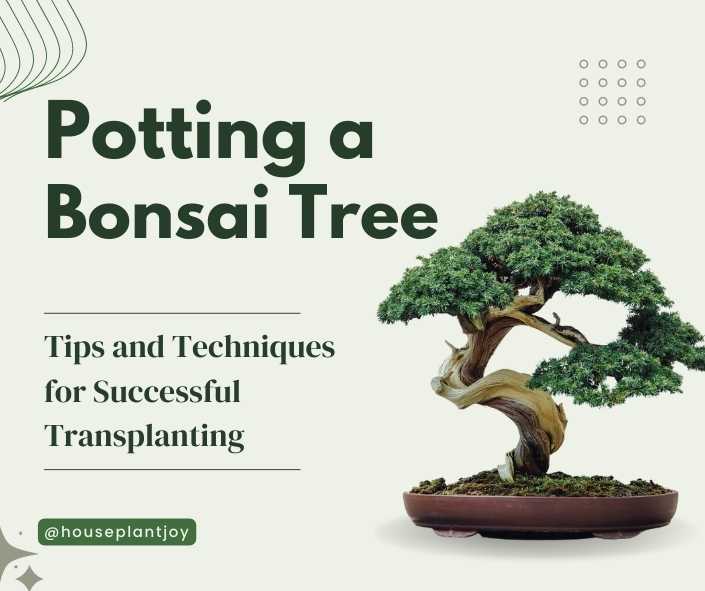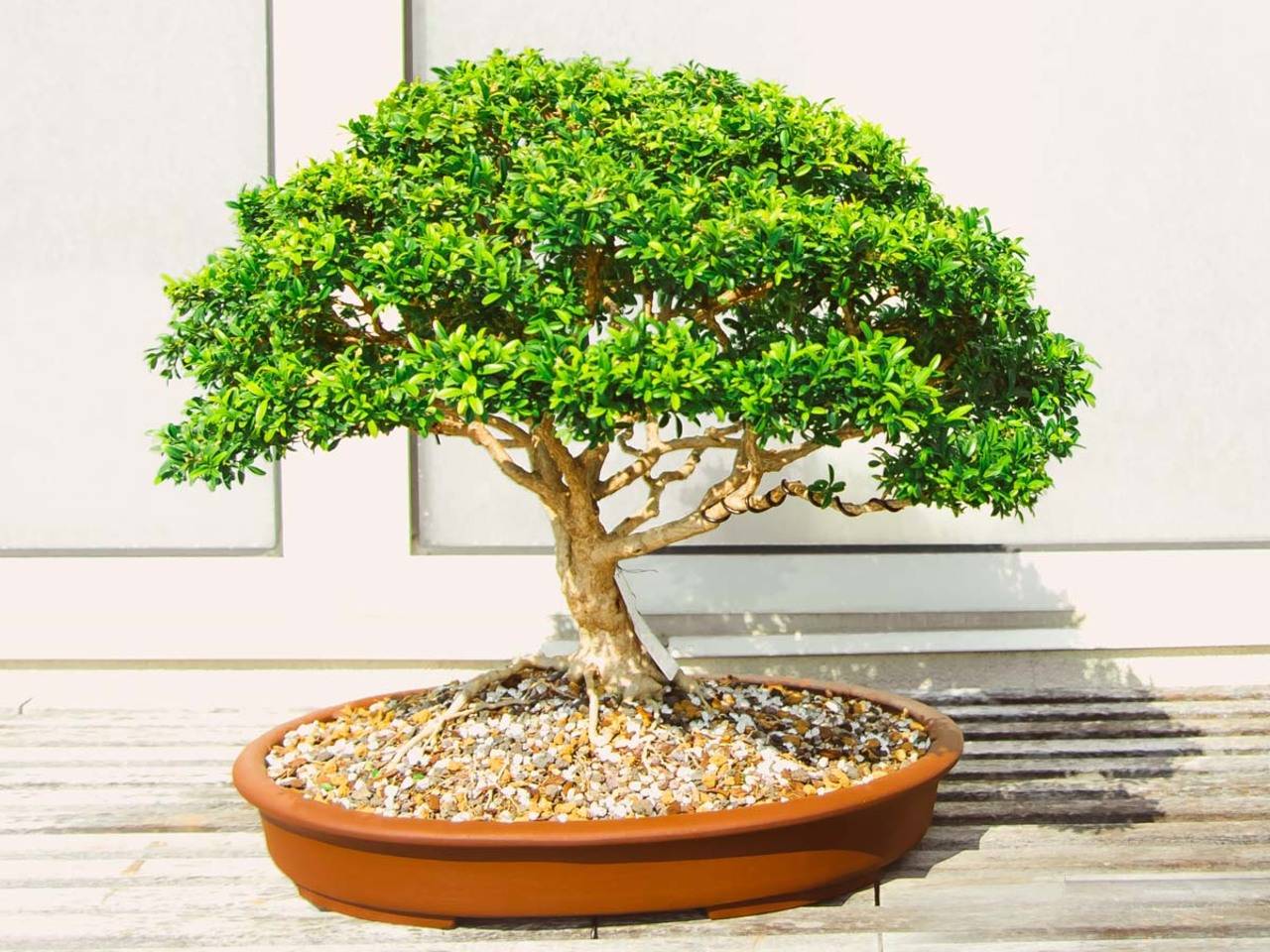HousePlantJoy is supported by our audience. When you purchase through one of our links, we may earn a small affiliate commission. As an Amazon Associate I earn from qualifying purchases. Your cost is not affected.
==================
Potting a Bonsai Tree is horticulture and art. These are little trees grown in containers. They’re taught to look like their full-size counterparts. Bonsai was first practiced in China around a millennium ago.
Repotting a bonsai tree is fundamental to its upkeep and development. When you pot a tree, its present is dumped out the container and has pruned roots. Transplant it in a different container with fresh soil. This procedure is essential to the survival and development of the tree.
The timing of repotting a bonsai tree is critical. Little bonsai pots might become too confining for the tree’s roots. Roots can become entangled and compacted over time. It prevents the tree from absorbing soil moisture and nutrients. Repotting promotes the tree’s continued health. It is also vital to allow the roots to expand and develop.
Through careful potting, a tree can direct its growth. Also, the tree can be molded to any desired form by manipulating its roots and branches. Removing diseased or broken roots is another way potting can benefit a tree’s health.
Potting a bonsai tree can be difficult. It can be hard without the proper equipment and background, but it’s simple. The trick is to go slow and protect the tree and its roots from harm. You will see an instant difference in the health and beauty of your bonsai tree after you have repotted it. If you take good care of your bonsai tree, it will flourish and provide you joy.
When To Report Bonsai Tree
The timing of repotting is crucial for a healthy bonsai tree. Repotting can be stressful for the tree, but waiting too long can bring problems like root rot. Thus, take into account the following when choosing to repot your bonsai tree:
When to repot your plant, look for these signs:
- Impaired drainage because of soil compaction,
- Roots are sprouting through the pot’s drainage holes.
- Leaves turning yellow and development slowing are symptoms of stress in a tree.
- As the duration between repottings reaches two years or more, it’s time to do it again.
When To Repot Your Plants
Potting the Bonsai trees in the early spring before new growth begins when they are dormant. Repotting in the winter allows the tree to conserve its energy. It is crucial for growth rather than dealing with uprooted trauma.
A bonsai tree’s repotted frequency depends on age, size, soil, and growth rate. Do the repotting every year to two years for smaller trees and every three to five years for elder trees. It is a must for regular soil testing and tree development observation. It is to determine when repotting the factors affecting it.
Monitoring the soil’s quality and your bonsai tree’s general health is critical. It is important to determine when to report. You can ensure the tree’s health and longevity by repotting its dormant period. You can achieve it by using appropriate soil and tools and closely monitoring its development. Repotted Bonsai trees must be part of their maintenance. Through the right approach, your tree will thrive.
Materials Needed for Potting
The success of potting a bonsai tree depends on having all the necessary components on hand. Bonsai tree potting requires the following:
Bonsai pot sizes, styles, and materials vary. Clay is the usual material, but plastic, ceramic, and wood are acceptable alternatives. The pot should have drainage holes to prevent root rot and be of an appropriate size for the tree.
Your bonsai tree’s health and growth depend on the soil type and mixture you use. The soil used for bonsai should be porous and aerated. It promotes healthy root development. Some of the soil options available are mixtures of akadama, pumice, lava rock, and organic materials such as peat moss or bark. The appropriate proportions of soil ingredients will vary from tree to tree.
Potting will be easy if you’re prepared with the correct equipment. Some of the most necessary implements are as follows:
- Pruning Shears: Shears for removing excess tree parts, such as roots and limbs.
- Root Hook: Use a root hook to loosen soil and separate tree roots.
- Soil Scoop: To fill the bonsai container with soil, use a bonsai soil scoop.
- Can of water: for hydrating the tree after repotting.
- Wire for shaping: Using a mesh screen to cover the drainage holes in the pot are two more items that may come in handy.
It is important to have a proper container, soil, and tool for potting a bonsai tree. Using high-quality materials can protect the tree and encourage its development. It can also result in a stunning piece of art.
Guide Step on Bonsai Tree Repotting
Careful attention during the delicate process of repotting a bonsai tree. Thus, below, you will find guidance on how to repot a bonsai tree.
Preparation of Materials
Before repotting your bonsai tree, you must organize your new pot. Prepare the soil mixture and equipment. To ensure the tree’s health, it’s best to water it for several days before repotting.
Remove the soil around the sides of the pot with a root hook or chopstick until you can take the tree out of the pot. Avoid damaging the tree’s trunk or branches. After the soil is free, lift the tree.
Preparing the Pot with Soil Mixture
The bottom of the filled new pot with soil before the relocated tree. This layer will protect the tree’s roots from waterlogged. It would help to place a mesh screen over the pot’s drainage holes.
The planted tree in the center of the new pot once prepared. If necessary, readjust the tree’s location until it is horizontal and centered. Wire can secure the tree, but too much wrapping could damage the bark.
After the tree fills in the new pot, you can add the soil. First, scoop some soil and fill the spaces surrounding the roots. Packing the soil around the roots is essential without damaging them. Keep adding soil until the container is full.
Damp the Potted Plant
After you’ve put soil in the pot, water it so it’s damp all through. To help keep the soil moist and for aesthetic purposes, you may spread moss or some other ground cover.
In conclusion, a bonsai tree’s potting process is time-consuming and exacting. Yet, you may repot your bonsai tree and encourage its health and growth. Following these instructions and using the appropriate materials is important. The tools you can have helps in a successful repotting. Tending to your bonsai tree will result in a flourishing, beautiful plant. It will bring joy year after year.
Tips on How to Plant a Bonsai
Potting a bonsai tree requires patience, focus, and a steady hand. While looking for a new bonsai pot, keep the following in mind:
- After repotting your bonsai tree, you still need to give it attention. So, once you’ve planted your bonsai tree in its pot, remember these things:
- Bonsai trees need consistent watering to flourish. To begin, hydrate the ground whenever you discover it to be dry.
- Afterward, give your bonsai tree a balanced fertilizer. It is to ensure its health and growth. Follow the application instructions on the fertilizer’s packaging for the best results.
- Take note of pests like spider mites and aphids, as they can cause damage to your bonsai tree. Watch for signs of infestation, including leaf yellowing and webbing. These signs can help to take appropriate action.
- Maintaining the ideal form and size of your bonsai tree requires regular trimming. Use pruning shears to trim back new growth as needed.
Potting a bonsai tree requires patience, care, and attention to detail. These tips will ensure your bonsai tree retains its exquisite beauty for many years.
Tips For Placing Your Bonsai Tree
A bonsai tree’s health and longevity are both guaranteed by its container. Before you can get your tree into a pot, please give it a good trim around the base and the branches.
- Take the tree out of its current pot but be careful not to damage the roots or the branches.
- Create a tiny mound of soil in the center of the new container.
- Spread the tree’s roots out after placing them on the mound.
- Ensure the tree is secure by filling in any gaps with soil and pressing down.
- Let the tree rest for a few days in the shade and water.
- Choose the right saucepan. The roots of your tree should be able to squeeze in there.
If you want your tree to thrive, plant it in soil that drains well. Avoid watering your Bonsai tree too often since this could kill the tree. It would help if you were patient with your tree adjusting to its new environment.
Benefits of Potting a Bonsai Tree
- Trees enjoy repotting because it encourages healthy root development.
- Your tree will get the nutrients it needs to flourish when you plant it in new soil.
- Repotting increases drainage, which reduces the risk of root rot and other issues.
- Sculpting a tree to your specifications is easy when you plant it in a container.
Regular repotting is a crucial element of bonsai care. It can increase the longevity of your tree. You may repot your bonsai tree following the advice in this article and watch it flourish for years to come.
Knowing how to pot a bonsai properly will improve your little tree’s success rate. This video how to do it, when, and why it is important to use good soil. Enjoy!
Video Credit: @WeareTheBonsaiSupply
The Art of Potting: A Guide to Bonsai Tree Care
A bonsai tree’s sustained growth and health depend on routine root pruning. Use pruning shears to remove sick or dead roots before repotting your tree. Root hooks or chopsticks can loosen any remaining clumps of soil and roots. It can scrape the old soil can away. Avoid uprooting a tree, too, as this could put undue strain on it and slow its growth.
While repotting a bonsai tree, be careful not to damage its fragile branches and leaves. Unpot the tree without yanking or bending any of the branches. It is possible to shape a tree with wire, but careful wrapping is crucial to avoid damaging the bark.
After repotting your bonsai tree, rinse it to help the soil settle and stimulate new root growth. Maintain a steady moisture level in the soil around the tree by watering it. Root rot and other problems can cause by overwatering, so take care.
To Our Readers, With Thanks and Best Wishes
We hoped you found our post about bonsai tree potting to be very informative. Feel free to send us a message if you have any relevant experience and would like to share it with our readers. Reader feedback is very important to us. Check out the rest of our site for even more gardening advice. Thank you for reading, and I hope you have success with your bonsai!
More Interesting Stuff!
Frequently Asked Questions – Potting a Bonsai Tree
Can I bring my little bonsai tree inside?
It is on the type of tree. If given the right conditions, bonsai trees like ficus and jade can flourish in the home. Access to natural sunshine and temperature changes may be essential for other species.
What is the recommended watering schedule for a bonsai tree?
The amount of water a tree requires changes with its species, soil type, and climate. Watering bonsai trees is best done when the top inch of soil is dry. The cause of root rot is overwatering. Thus, don’t do that.
How do I know if my bonsai tree is getting too little light?
To thrive, bonsai trees are best exposed to indirect, bright sunshine. Yellowing leaves, slow development, and brittle stems state that your bonsai tree isn’t getting enough light. Your bonsai tree will thrive in bright, filtered light, so locate it near a window if possible.
How to prune my bonsai tree?
Pruning is essential to caring for a bonsai tree to shape the tree and encourage new growth. Make clean cuts at a 45-degree angle using sharp, sterile tools. Only take off a third of the leaves during the growing season.
To what extent should I fertilize my bonsai tree?
Bonsai plants need regular feedings of fertilizer to thrive. Apply a well-balanced fertilizer following the directions provided. During the growing season, fertilize every two weeks. The less fertilizer in the winter will need.
How free am I to get creative with the shape of my bonsai tree?
The species constrain your bonsai tree’s design’ and your tree’s age. So trimming and wiring can give your tree a specific shape. It’s best to respect the tree’s inherent characteristics rather than try to alter them.
If the root mass of your bonsai tree is vast, how do you recommend repotting it?
Root pruning is important before repotting if your bonsai tree has a huge root mass. The tree must unpot and any dead or damaged roots trimmed away. Avoid damaging the tree’s roots too much as you repot it into a larger container with new soil.









